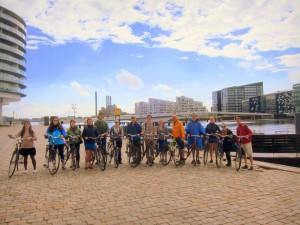Spring term has just ended and most students are enjoying their summer breaks, but 14 students are already back in the classroom. We shouldn’t feel too bad for them because their classroom is in Copenhagen, Denmark, as a part of their three-week Sustainable Bicycle Transportation course in Denmark and the Netherlands.

The students are led by UO Associate Professor Marc Schlossberg. He has planned a three-week itinerary that begins in Copenhagen and continues to Utrecht, Netherlands, and then moves to Amsterdam. In each of the cities, students will do coursework, experience the urban environment on bike, meet with local leaders, and keep a diary of their experiences.

While the diary of their experiences is written for themselves and their instructor only, all students and Schlossberg are writing more publicly about their experiences in individual blogs. They arrived less than a week ago, but most students have posted their first reactions to bike culture in Copenhagen and posted pictures that illustrate their experiences. For all of the students’ blogs, check out the class blog directory.
Here are a few highlights from the blogs so far:

Molly Bacon posted a detailed account of the first three days in Copenhagen.
“I conclude from my time cycling in Copenhagen that bicycling is natural. Everyone here is just doing it. It has rained every day I’ve been here and I’ve been told this is normal. They don’t even really bother to cover their bicycle seats when it’s parked in the rain, like many people in Eugene do. It’s just so common that bicycling is a way of living. The hipsters ride fixed gears just like in the USA. People bike in the rain or sun, either way they will still bike because it’s just more convenient.”

Emma Newman chronicled the scavenger hunt by bike the students embarked on in their second day in Copenhagen.
“It was really great to talk with locals and compare the bicycle infrastructure here to some of the infrastructure that we have back home. There are so many simple changes that could be made throughout our cities in the U.S. that would make bicycling more feasible and safer.”

Kory Northrop documented specific infrastructure improvements that make cycling in Copenhagen easier and safer than cycling in the United States.
“Stop lines for cyclists are often placed a few meters in front of the stop lines for automobiles to increase visibility and safety. “Right hooks” are still an issue in Copenhagen, but this simple treatment has made a difference. Retrofitting lorries with additional mirrors is another simple technique to decrease the likelihood of collisions.”

Marc Schlossberg posted a round up of some of the first experiences on the trip so far.
“It is quite satisfying to be on a bike and be part of the dominant mode where all vehicles yield always (and where cyclists all yield to pedestrians always).”
The students will continue to update their blogs as they move to the Netherlands, so keep following along. The blogs demonstrate what the students learn from the experience, but also take everyone else along and teach us about what is needed to build a successful bicycle network and culture.